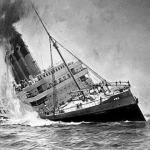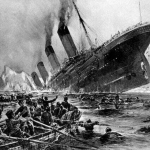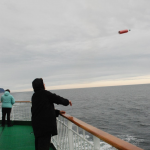Message In A Bottle

 One of the most romantic ideas in storybook romances, a message in a bottle has captivated our imaginations for years, but this was not just something in a storybook. It seems that it has gone on for centuries. In fact the oldest known message in a bottle has a date was dated June 12, 1886. The message was found in 2018 on a West Australian beach. The message indicated that it had come from a ship called Paula. The finder, Tonya Illman assumed the message was a hoax. However, her husband did some research online. There was a date on the message, which corresponded with an ongoing program conducted in Germany from 1864 to 1963. Captains routinely threw bottles in the sea and wrote down the name of the ship, the date, the precise coordinates, and the travel route. Because the message included this information, they took the bottle to a maritime museum. A curator determined that the message was authentic and was released as part of the program. Similar messages have been found. A message found in 1999, found bobbing around in the Thames by a local fisherman was from a young British soldier named Private Thomas Hughes. It was 1914, the first year in the war. Hughes was lonely aboard a transport ship. He wrote a letter to his wife, but had no way to mail it.
One of the most romantic ideas in storybook romances, a message in a bottle has captivated our imaginations for years, but this was not just something in a storybook. It seems that it has gone on for centuries. In fact the oldest known message in a bottle has a date was dated June 12, 1886. The message was found in 2018 on a West Australian beach. The message indicated that it had come from a ship called Paula. The finder, Tonya Illman assumed the message was a hoax. However, her husband did some research online. There was a date on the message, which corresponded with an ongoing program conducted in Germany from 1864 to 1963. Captains routinely threw bottles in the sea and wrote down the name of the ship, the date, the precise coordinates, and the travel route. Because the message included this information, they took the bottle to a maritime museum. A curator determined that the message was authentic and was released as part of the program. Similar messages have been found. A message found in 1999, found bobbing around in the Thames by a local fisherman was from a young British soldier named Private Thomas Hughes. It was 1914, the first year in the war. Hughes was lonely aboard a transport ship. He wrote a letter to his wife, but had no way to mail it.
In 1956, a young Swedish man named Ake Viking was out at sea and lonely for love. One evening, he decided to send his quest for love out into the ocean via a message in a bottle. The note included his contact information and a message that read, “To Someone Beautiful and Far Away.” He did not seriously think anything would come of it, but two years later he received a response from an Italian woman named Paolina.  When she wrote back to him, she explained: “[it’s] so miraculous that [the bottle] should have traveled so far and long to reach me that I must send you an answer.” They wrote letters back and forth, and fell in love through the letters. Eventually, they met. Viking left his life at sea, married Paolina, and moved to Sicily.
When she wrote back to him, she explained: “[it’s] so miraculous that [the bottle] should have traveled so far and long to reach me that I must send you an answer.” They wrote letters back and forth, and fell in love through the letters. Eventually, they met. Viking left his life at sea, married Paolina, and moved to Sicily.
It amazes me, but probably shouldn’t, that people whose ship is sinking might have the foresight to write a note and put it in a bottle, and drop it over in the hope that it might be found later. Nevertheless, people on both Titanic and Lusitania actually did. A young Irishman named Jeremiah Burke was traveling on Titanic, with a cousin to join their family in Boston. Before his departure from Ireland, his mother had given him a small bottle of holy water. In his last moments, Burke put his note into the bottle and cast it into the sea. His note read: “From Titanic, goodbye all, Burke of Glanmire, Cork.” Sadly, both Burke and his cousin died in the sinking, but his poignant message washed ashore in the bottle a year later, just a few miles from his home.
The Lusitania sunk by a German torpedo in May 1915, while on its way from New York to Liverpool. The Lusitania sank in only eighteen minutes. More than 1,000 people lost their lives. One passenger aboard who had the presence of mind and the time to dash off a quick note, put it in a bottle, and set it adrift before the end came. The unknown author chillingly wrote: “Still on deck with a few people. The last boats have left. We are sinking fast. Some men near me are praying with a priest. The end is near. Maybe this note will…” There was no time to write more. He rolled the message, placed it in the bottle, and threw it in, before the boat sank. How could he have had the forethought to write a message.

 Harold Hackett is a resident of Prince Edward Island in Canada. He had a lifelong interest in the mystery of messages floating in bottles. In 1996, the amateur fisherman decided to experiment, sending messages in bottles out to sea and wait for the results. To increase his chances of having even one bottle retrieved by someone, he sent more than 4,800 bottles with messages into the sea. Over the years, he has received more than 3,000 responses from the delighted people who found them. I guess, we still love the storybook idea of a message in a bottle.
Harold Hackett is a resident of Prince Edward Island in Canada. He had a lifelong interest in the mystery of messages floating in bottles. In 1996, the amateur fisherman decided to experiment, sending messages in bottles out to sea and wait for the results. To increase his chances of having even one bottle retrieved by someone, he sent more than 4,800 bottles with messages into the sea. Over the years, he has received more than 3,000 responses from the delighted people who found them. I guess, we still love the storybook idea of a message in a bottle.
- December 2024
- November 2024
- October 2024
- September 2024
- August 2024
- July 2024
- June 2024
- May 2024
- April 2024
- March 2024
- February 2024
- January 2024
- December 2023
- November 2023
- October 2023
- September 2023
- August 2023
- July 2023
- June 2023
- May 2023
- April 2023
- March 2023
- February 2023
- January 2023
- December 2022
- November 2022
- October 2022
- September 2022
- August 2022
- July 2022
- June 2022
- May 2022
- April 2022
- March 2022
- February 2022
- January 2022
- December 2021
- November 2021
- October 2021
- September 2021
- August 2021
- July 2021
- June 2021
- May 2021
- April 2021
- March 2021
- February 2021
- January 2021
- December 2020
- November 2020
- October 2020
- September 2020
- August 2020
- July 2020
- June 2020
- May 2020
- April 2020
- March 2020
- February 2020
- January 2020
- December 2019
- November 2019
- October 2019
- September 2019
- August 2019
- July 2019
- June 2019
- May 2019
- April 2019
- March 2019
- February 2019
- January 2019
- December 2018
- November 2018
- October 2018
- September 2018
- August 2018
- July 2018
- June 2018
- May 2018
- April 2018
- March 2018
- February 2018
- January 2018
- December 2017
- November 2017
- October 2017
- September 2017
- August 2017
- July 2017
- June 2017
- May 2017
- April 2017
- March 2017
- February 2017
- January 2017
- December 2016
- November 2016
- October 2016
- September 2016
- August 2016
- July 2016
- June 2016
- May 2016
- April 2016
- March 2016
- February 2016
- January 2016
- December 2015
- November 2015
- October 2015
- September 2015
- August 2015
- July 2015
- June 2015
- May 2015
- April 2015
- March 2015
- February 2015
- January 2015
- December 2014
- November 2014
- October 2014
- September 2014
- August 2014
- July 2014
- June 2014
- May 2014
- April 2014
- March 2014
- February 2014
- January 2014
- December 2013
- November 2013
- October 2013
- September 2013
- August 2013
- July 2013
- June 2013
- May 2013
- April 2013
- March 2013
- February 2013
- January 2013
- December 2012
- November 2012
- October 2012
- September 2012
- August 2012
- July 2012
- June 2012
- May 2012
- April 2012
- March 2012
- February 2012
- January 2012
- December 2011
- November 2011
- October 2011
- September 2011
- August 2011
- July 2011
- June 2011
- May 2011
- April 2011
- March 2011
- February 2011
- January 2011
- December 2010
- August 2010
- July 2010


Leave a Reply